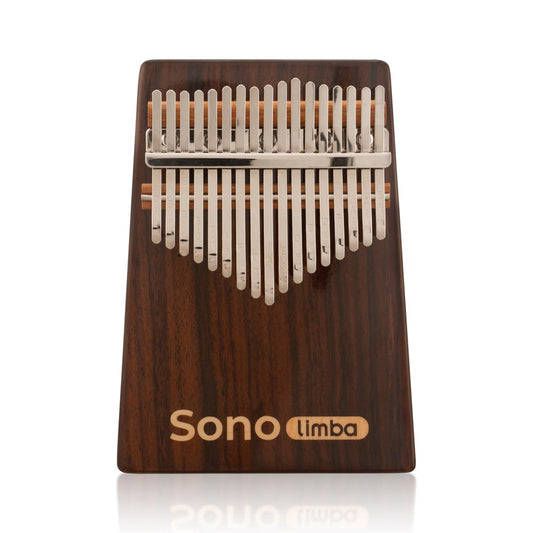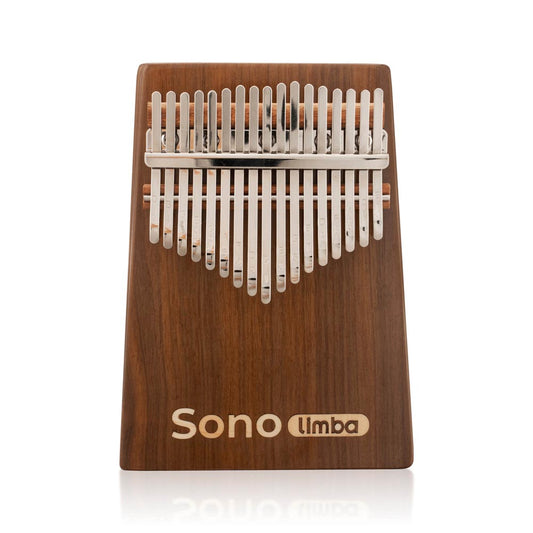Collection: Self-ringing instruments
-
Sonodrum Kalimba - Sonolimba - African Coral Wood
Regular price From 69,95 €Regular priceUnit price / per99,95 €Sale price From 69,95 €Sale -
Sonodrum tongue drum - "Exclusive" - Handmade - 38cm - 14 tongues - C major
Regular price 299,95 €Regular priceUnit price / per499,95 €Sale price 299,95 €Sale -
Sonodrum Kalimba - Sonolimba - Rosewood
Regular price From 79,95 €Regular priceUnit price / per99,95 €Sale price From 79,95 €Sale -
Sonodrum Kalimba - Sonolimba - Walnut wood
Regular price From 79,95 €Regular priceUnit price / per99,95 €Sale price From 79,95 €Sale -
Sonodrum Kalimba - Sonolimba - Acacia wood
Regular price From 79,95 €Regular priceUnit price / per99,95 €Sale price From 79,95 €Sale -
Sonodrum tongue drum - "Premium" - Handmade - 35.5cm - 15 tongues - C major
Regular price 229,95 €Regular priceUnit price / per399,95 €Sale price 229,95 €Sale -
Sonodrum tongue drum - "Standard" - Handmade - (14cm / 20cm) - 8 tongues - C major
Regular price From 89,95 €Regular priceUnit price / per159,95 €Sale price From 89,95 €Sale -
(NEW) Sonodrum tongue drum - "Standard" - Handmade - 30cm - 11 tongues - C major
Regular price 139,95 €Regular priceUnit price / per279,95 €Sale price 139,95 €Sale -
Sonodrum tongue drum - "Standard" - Handmade - 30cm - 11 tongues - D major
Regular price 139,95 €Regular priceUnit price / per279,95 €Sale price 139,95 €Sale -
Sonodrum Handpan / Sonopan
Regular price 1.499,00 €Regular priceUnit price / per1.799,00 €Sale price 1.499,00 €Sale -
Sonodrum tongue drum - yoga/relaxation starter set
Regular price 249,95 €Regular priceUnit price / per534,80 €Sale price 249,95 €Sale
Music is a fascinating world, full of sounds, rhythms and emotions. Before you delve into the world of automatic instruments , let's take a look at how you can learn about music. Music is more than just notes on a piece of paper. It is a language that expresses feelings and tells stories. When you listen to music, you not only learn about the melodies, but also the emotions they convey.
An important part of music is the various instruments that bring it to life. Idiophonic instruments - also known as self-sounders - are a fascinating category of instruments that create sound by making themselves vibrate . You don't need an external source to create sound, you use your own structure and resonance.
Self-sounding instruments belong to this family of idiophones . They are unique because they are designed to produce sound through their own movement. These instruments often have a simple but effective design and can produce a variety of sounds , from gentle tones to powerful rhythms. Their independence brings a very special dynamic to the world of Sonodrum music .
What are self-sounding instruments?
Self-sounding instruments are fascinating musical instruments that produce sounds by making themselves vibrate. They belong to a family called idiophones and are characterized by their independent sound production . These instruments offer a diverse range of sounds and include a wide selection, including mallet instruments such as glockenspiels and xylophones , as well as metal instruments such as kalimbas and mbiras . Modern innovations such as the hang drum or handpan expand the spectrum of this fascinating genre of instrument, which offers musicians and listeners alike unique sound experiences. Here are some examples of self-sounding instruments:
-
Mallet instruments : These instruments consist of a series of bars that can be made of different materials such as wood, metal or plastic . When the bars are struck, they produce different sounds.
-
Chimes : Chimes consist of metal bars that are mounted in a fixed arrangement. By striking the bars with a mallet, clear and bright tones are produced.
-
Xylophones : Similar to glockenspiels, xylophones consist of bars , but they are often made of wood. They produce warm and resonant sounds.
-
Metallophones : These idiophone instruments are similar to xylophones, but use metal bars instead of wooden ones. This produces bright and powerful sounds.
-
Kalimbas : Kalimbas, also known as thumb pianos , consist of metal tongues or reeds mounted on a resonating box. Plucking or striking the tongues with the fingers produces melodic sounds.
-
Mbira : This African finger piano is similar to the kalimba, but consists of a special arrangement of metal tongues mounted in a resonance box .
-
Hang Drum : This sound drum is a modern development consisting of two connected, curved metal domes. By striking the domes with the hands, it produces spherical and soothing sounds.
These self-sounding instruments are diverse and unique in their range of sounds. Each of them has its own character and contributes to the musical landscape in its own way.
Buying a self-chiseling device - what should you pay attention to?
When purchasing a self-recorder, there are some important aspects to consider to ensure you choose the right instrument. Here are some points to look out for:
-
Sound quality: Check the sound quality of the instrument thoroughly. Make sure that the tones are clear and balanced and that the instrument produces the desired tonal nuances.
-
Material: Examine the material of the instrument carefully. High-quality materials such as wood or special metals can affect the sound quality and longevity of the instrument.
-
Build quality: Check the build quality of the instrument for any defects or irregularities. Make sure that all parts are well assembled and fastened.
-
Playability: Test the playability of the instrument to make sure it is comfortable and easy to play. Look for ergonomic features and comfort when holding and playing.
-
Accessories: Consider whether the instrument requires accessories such as mallets, stands or carrying bags and whether these are included or have to be purchased separately.
By considering these aspects, you can ensure that you purchase a high quality idiophone that meets your musical needs .
Self-sounding instruments in the test - how good are our tongue drums, handpans and co.
When it comes to self-sounding instruments such as tongue drums , handpans and similar idiophone instruments , Sonodrum.net offers a comprehensive review. The site rates these instruments in terms of their sound quality, workmanship, playability and value . Through their detailed reviews and comparisons, they help you find the best options on the market. It is advisable to read the reviews on Sonodrum.net to make informed decisions when purchasing self-sounding instruments. The reviews for Sonodrum instruments are consistently excellent and crucial for the German market.
Handpan
The handpan is a hand-played melodic instrument with a unique richness of sound and a meditative sound spectrum . Its curved shape and the special mood of the sound fields create a calming and inspiring soundscape.
Kalimba
The Kalimba , also known as a finger piano, is a handy and melodic instrument with metal tongues that produces soft and harmonious tones . Its compact size and easy playability make it a popular companion for on the go.
Tongue drum
The tongue drum is a fascinating percussion instrument with a series of reeds that produce melodic sounds when struck with the fingers. Its versatile sound possibilities range from gentle and soothing to dynamic and powerful.
Thumb piano
The thumb piano is a small, handy instrument with metal reeds that produces melodic tones simply by plucking or striking it with the thumbs. Its intuitive playing style and warm sounds make it a popular instrument for beginners and experienced musicians.
Finger piano
The Finder piano is a traditional African instrument played by plucking or striking the metal tongues with the fingers. Its unique sound patterns and rhythms fascinate and inspire musicians all over the world.
Sound drum
The sound drum is a hand-played percussion instrument with a round resonator and reeds that produce melodic tones when struck with the fingers. Its versatile sound possibilities and ease of play make it a popular instrument in various musical genres.
Shaman drum
The shaman drum is a powerful percussion instrument with a large, round frame and a natural eardrum membrane. Its deep and resonant voice creates a spiritual atmosphere and is often used for meditative purposes and ritual practices .
Idiophones in different materials and colors
Idiophones are fascinating musical instruments that produce sounds by vibrating themselves. They are often made from a variety of materials , each giving it its own unique sound and character.
Metal self-ringers are particularly popular and offer a wide range of tones. Aluminum self-ringers, for example, produce bright and clear tones, while steel idiophones can have a powerful and penetrating sound. Copper self-ringers , on the other hand, often produce warm and resonant tones that add a special depth. Bronze self-ringers are also known for their versatile sound properties and robust construction.
In addition to metal self-ringers, there are also wooden instruments that produce a warm and natural sound. Wooden idiophones such as xylophones or glockenspiels are often made from hardwoods such as mahogany or maple , which offer high sound quality and durability.
There are also plastic self-ringers, which are often available in bright colors and are particularly suitable for use in schools or children's groups. These instruments are light and robust, which makes them ideal for use in class or on the go.
Regardless of material and color, self-sounding instruments offer a diverse and inspiring world of sound that fascinates musicians and listeners alike. With their unique sound properties and creative design options , they enrich the world of music and invite you to discover new worlds of sound.
Choosing the right idiophone instruments
When choosing the right idiophone instruments, it all depends on your requirements and preferences . First, think about what you want to use the instrument for. For example, if you like to play at home and value a warm and relaxed sound, wooden idiophones such as xylophones or kalimbas could be a good choice.
On the other hand, if you travel a lot and are looking for a lightweight and sturdy instrument, plastic idiophones like glockenspiels might be a better option. They are easy to transport and can also be played outdoors without having to worry about damage.
You should also consider your personal preferences and needs. For example, if you have large fingers, you might choose an instrument with larger keys or sound panels to allow for comfortable playing. Conversely, people with small hands might prefer instruments that have a more compact design.
Ultimately, choosing the right idiophone is a very individual decision that depends on your personal preferences, playing style and intended use. It's worth trying out different instruments and exploring options tailored to your own needs to find the perfect idiophone for you.
Proper care of self-sounding instruments
Proper care of self-sounding instruments is important to maintain their sound quality and lifespan. One important aspect is regular cleaning of the instruments. Use a soft cloth or brush to remove dust and dirt from the surfaces. Make sure that you do not use aggressive cleaning agents or sharp objects that could damage the material.
In addition, it is advisable to keep the instruments dry after playing to avoid rusting of metal parts. If you have played the instrument outdoors or it has been exposed to moisture, dry it thoroughly before storing it.
For wooden idiophones , it is important to protect them from excessive moisture and temperature changes to avoid warping or cracking. If necessary, use a wood conditioner to protect the material and preserve its natural beauty.
Finally, keep instruments safe and secure when not in use. Use suitable storage bags or cases to avoid damage during transport and to protect the instrument from bumps or falls.
By caring for your self-sounding instruments regularly and treating them carefully, you can ensure that they will give you pleasure for a long time and can develop their full sound quality.
How to play an idiophone? Is it difficult to learn self-sounding instruments?
Playing an idiophone, whether it's an auto-ringer or otherwise, takes some practice and patience , but it can be very satisfying. The first step is to become familiar with the instrument by exploring its different parts and sound possibilities. After that, you can start playing simple melodies or rhythms by striking or plucking the keys or sound fields with your fingers or a mallet.
It is important to develop the basics of rhythm sense and hand-eye coordination to play the instrument effectively. Start with slow tempos and gradually build up as you develop more confidence and skill.
Whether self-sounding instruments are difficult to learn depends on several factors, such as your musical background, dexterity, and commitment to practice. For some people, learning an idiophone can be a challenging but rewarding experience , while for others it may be easier, depending on their individual abilities and preferences .
The most important thing is to remain patient and practice regularly to make progress and unlock the instrument's full potential. Over time, you will find that playing an idiophone becomes easier and you will venture into new musical worlds.
Conclusion: Self-sounding instruments
In summary, self-sounding instruments such as handpans , tongue drums and kalimbas offer a fascinating world of sound possibilities and musical inspiration. Their unique design and individuality make them an asset for musicians and listeners alike. Their diverse materials, colors and sound properties offer a wide range of options for every taste and purpose.
Choosing the right self-sounding instrument depends on individual preferences, needs and abilities . Whether you choose a metal instrument with clear and bright tones or a wooden idiophone with warm and natural sounds, the world of self-sounding instruments offers something for everyone.
Learning to play an auto-sounder takes some practice and patience , but it can be very rewarding. With regular practice and dedication, musicians can improve their skills and explore new sonic horizons.
Overall, self-sounding instruments are a unique and inspiring addition to any musical collection. With their versatility, creativity and beauty, they enrich the world of music and invite you to discover new sound experiences.
FAQ
What are self-sounding instruments?
Self-sounding instruments are musical instruments that produce sounds by vibrating themselves, without the need for an external source. They belong to the category of idiophones and include a variety of instruments such as handpans, tongue drums and kalimbas. Their independent sound production and diverse sound characteristics make them popular with musicians and music lovers worldwide.
How do self-sounding instruments work?
Self-sounding instruments function through the natural resonance of their structure. When struck, for example with fingers or a mallet, they cause their own parts to vibrate and thus produce sound. This happens without the need for an external power source or amplification. The specific construction and choice of materials of each instrument determines its sound characteristics and quality.
What types of self-sounding instruments are there?
There are a variety of self-sounding instruments that offer a wide range of sound possibilities. The most common types include handpans, tongue drums, kalimbas, sound drums, shaman drums, and thumb pianos. Each of these instruments has its own unique sound characteristics and playing techniques to explore and enjoy.
Are self-sounding instruments difficult to learn?
The ability to learn self-sounding instruments depends on individual factors such as musical background and willingness to practice. Some find it easier to get started than others. However, with regular practice and dedication, the basics can be acquired relatively quickly. Difficulty varies depending on the complexity of the instrument and the musical experience of the learner. Overall, learning self-sounding instruments can be challenging, but also rewarding and fulfilling.
What are the benefits of self-sounding instruments for relaxation?
Self-sounding instruments offer a variety of benefits for relaxation. Their gentle and soothing sounds can reduce stress, improve mood and contribute to an overall feeling of serenity. Playing these instruments can help you enter a meditative state and disconnect from everyday life. Their ease of playability and harmonious sounds make them ideal companions for relaxation practices such as meditation, yoga or just to unwind after a long day.
How do I choose the right self-sounding instrument for me?
To choose the right self-sounding instrument for you, consider your personal preferences and needs. Consider what sound you prefer and which instrument best suits your musical goals. Try out different instruments to test their sound quality and playability, then choose the one that appeals to you most. Also consider factors such as budget, size and portability of the instrument to make sure it meets your needs.
Can I also use self-sounding instruments for music production?
Yes, auto-sounding instruments can definitely be used for music production. Their unique sounds and textures can provide an interesting and organic addition to various music genres. Many producers incorporate auto-sounding instruments into their recordings to add atmosphere and character. With the right microphones and recording techniques, auto-sounding instruments can be professionally recorded and used in music productions, whether in live performances or studio recordings.
Are there any tips for the care and maintenance of self-sounding instruments?
Care and maintenance of self-tuning instruments includes regularly cleaning them of dust and dirt to maintain their sound quality. Keep metal parts dry to prevent rusting and store the instrument safely when not in use. For wooden idiophones, it is important to protect them from moisture and temperature changes. Regular tuning can also improve the sound quality. Follow the manufacturer's specific care instructions to ensure the longevity of your instrument.











